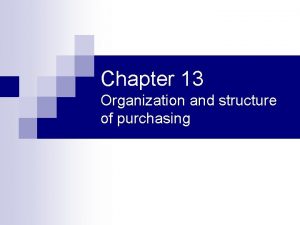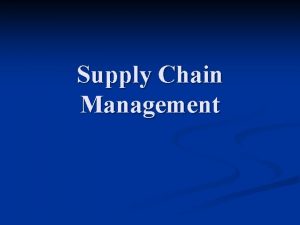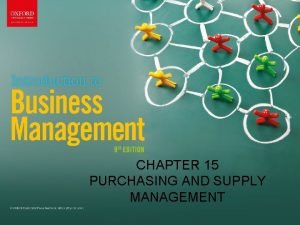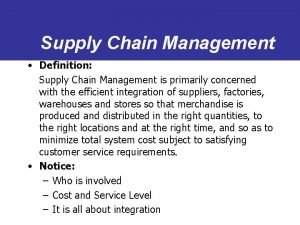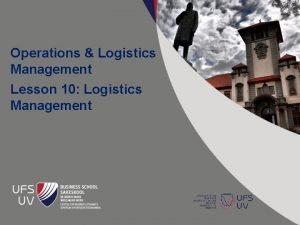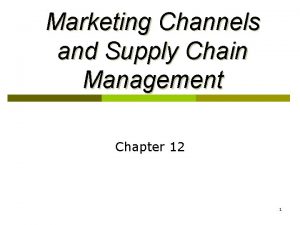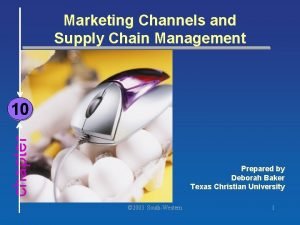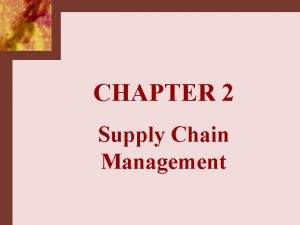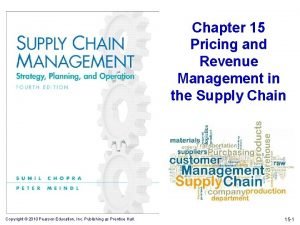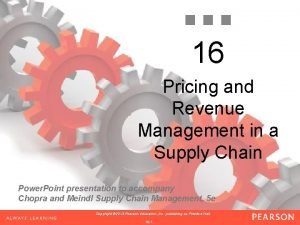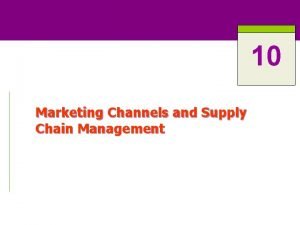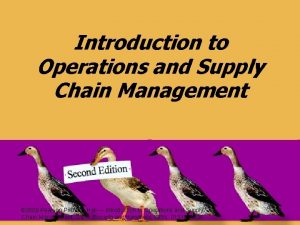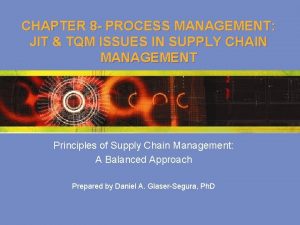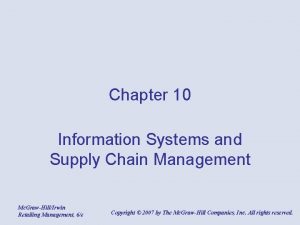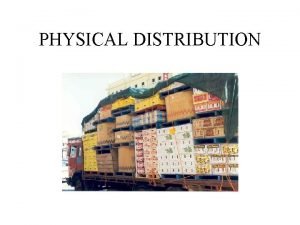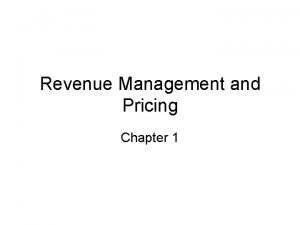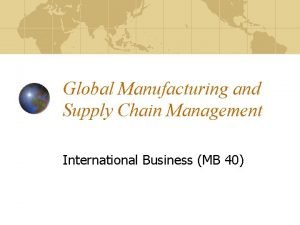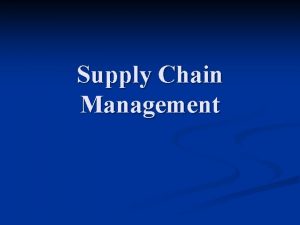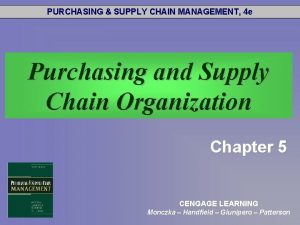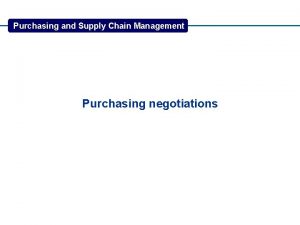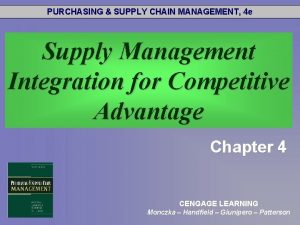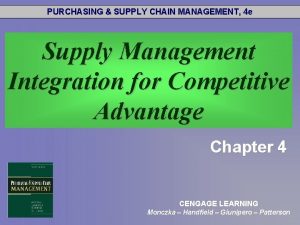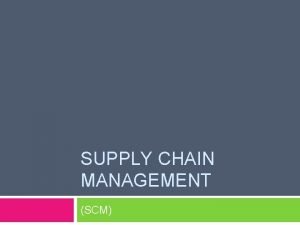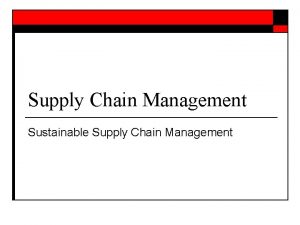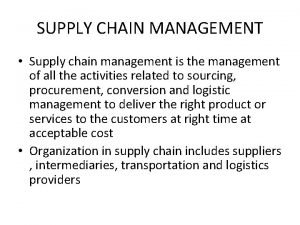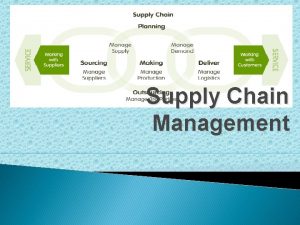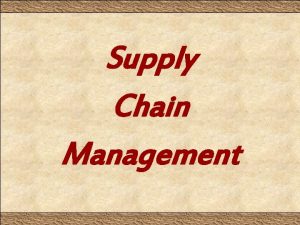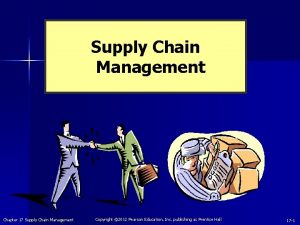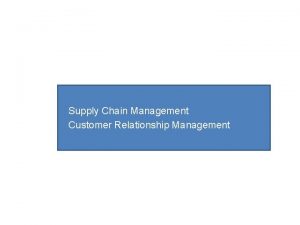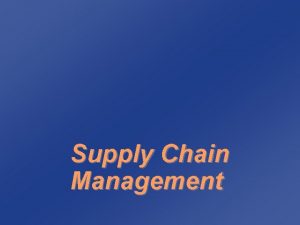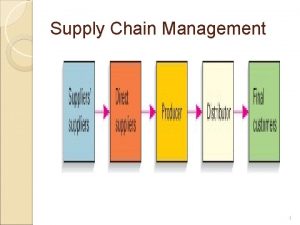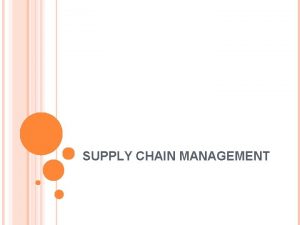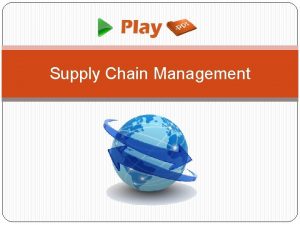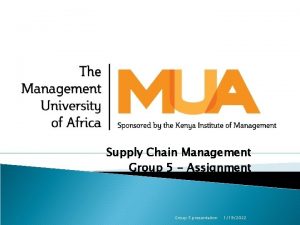Purchasing and Supply Chain Management Matching Supply with


























- Slides: 26

Purchasing and Supply Chain Management Matching Supply with Demand (Forecasting)

Matching Supply with Demand Inventory, Logistics and Supply Chain Management Definition of Inventory A term used to describe • all the goods and materials held by an organisation for sale or use • a list of items held in stock Source Institute of Logistics and Transport Inventory Management Forecasting Matching Supply with Demand Materials requirements planning MRP Manufacturing resource planning MRP 2 Enterprise resource planning ERP Matching Demand in Retail

Matching Supply with Demand Reasons for Keeping Inventory Reduce the risk of supplier failure Protect against lead-time uncertainties Meet unexpected demands Smooth seasonal or cyclical demand Lot size considerations Hedge against anticipated shortages and price increases Ensure rapid replenishment of items in constant demand

Matching Supply with Demand Aims of Inventory Management Provide internal and external customers with required service levels at optimum cost Ascertain present and future requirements for all types of inventory to avoid overstocking Keep stocks to a minimum by variety reduction Provide upstream and downstream inventory visibility in the supply chain

Requirement profiles: (a) constant rate; (b) increasing rate; (c) seasonal rate; (d) periodic rate

EOQ formulae

Stock-turn rate is calculated by dividing average stock for a period of time into total usage for the same period. The formula is: [Annual Usage Value / Average Inventory Value] This measures how quickly the inventory is used. The larger the ratio, the better the inventory is being used. Production application ABC analysis Demand type Other Raw materials Components Work-in-progress Sub-assemblies Finished goods A items B items C items Independent Maintenance, repair and operating materials (not embodied in the finished goods.

Effect on profit of improving stock-turn rate

Matching Supply with Demand Barcoding – EPOS (electronic point of sale) Read without being visible to the scanner Range Line of sight Be read over a very long range Bulk read RFID advantages Selectivity Read/write Durability Selective reading Barcodes vs RFID ?

Matching Supply with Demand Manufacturing/Assembly Type Organisations – Factors that Determine the Right Quantity The demand for the final product The inventory policy Economics of inventory: Acquisition costs Holding costs (proportional to the value of inventory, proportional to the physical characteristics) Cost of stockouts Loss of production output Idle time and fixed overheads Loss of goodwill Whether job, batch, assembly or process production methods are applicable Whether demand is independent or dependent The service level ? Market conditions – financial, political Factors determining EOQ

Matching Supply with Demand Qualitative – expert opinion, market survey, Delphi method. ? Optimize expenditures on necessary resources Forecasting Issues - Questions 1. What is the purpose of the forecast? 2. What is the time horizon? ? Long-term forecasts exceeding two years-strategic planning, great uncertainty Medium-term forecasts 3 months up 2 years, strategic + tactical planning Short-term forecasts less than three months, tactical planning, high level of accuracy. 3. What forecasting technique(s) is far most appropriate? Quantitative methods: time series, seasonal indexes, trends, cyclical movement 4. On what data must the forecasting be based and how shall it be analysed? Depends on purpose, accuracy required and available forecasting 5. In what form shall the completed forecast be presented? Purpose of forecast, assumptions, conclusions 6. How accurate is the forecast? . . . ascertain degree of accuracy. . . revison

Matching Supply with Demand Anticipation of demand production on long -term forecasts. High (relative) inventory level. Inventory Control Systems Production to specific orders, demand is certain and inventory is low or non-existent. “Push” Systems Elements of Both “Push” and “Pull” Systems Pre-determined re-order levels Periodic review systems MRP and OPT systems JIT, JIT II, Kanban

Matching Supply with Demand Why Purchasing Professionals Should Have a Grasp of Inventory Management 1 Inventory is an asset. 2 Inefficient inventory management will increase costs and reduce profitability. 3 Inventory can enhance flexibility and provide competitive advantages. 4 It needs the co-operation of efficient and effective suppliers. 5 The armed forces need inventory to maintain operational readiness and performance.

Developing the master production schedule

Material requirement planning: Geared with assambly operations Dependent demand technique Computer based information system Enterprises resource planning (ERR): Significant development of MRP and MRPII. Modules: finance, logistics, manufacturing, supplier management, human resources. . Management system supporting multimodule application software integrates all the departments and functions of company. Manufacturing resource planning (MRP II): Extension of computerized MRP to link together such functions: production planning, engineering, purchasing, marketing, financial/cost accounting. . . into integrated decision support system. Flows of information and materials in a material requirements planning system

A simple kanban system Source: Hahn et al. , 1983

The ‘milk round’ routeing of collection transport

The power of late customisation

Matching demand in Retail • To analyse the role of the retail buyer and their involvement with the supply chain • To differentiate between selector, buyer and merchandiser • To understand retailing research and the different methods of collecting data • To define all the aspects involved in merchandising • To appreciate the value of brand names and how they compete with ‘own brand’ labels and generics • To understand the concept of efficient consumer response

Supply chains in retailing

Schematic representation of an EDI system

What is efficient consumer response (ECR)? Over several years, the authors have received numerous definitions of ECR from a multitude of retailers. The following are just a small selection. ‘ECR is a grocery industry strategy in which distributors, suppliers jointly commit to work closely together to bring greater value to the grocery consumer. ’ ‘Efficient consumer response – a strategy in which the grocery retailer, distributor and supplier trading partners work closely together to eliminate excess cost from the grocery supply chain whilst improving customer value. ’ ‘Efficient consumer response is a “strategic initiative” working to overcome traditional barriers between trading partners, thus eliminating internal barriers, that result in costs and time that add little or no value to consumers. ’

Barriers to the successful implementation of ECR • • Traditional barriers between trading partners. Barriers within companies, between internal departments. Unwillingness to share information. Conflicts with other priorities. Inflexible information systems. Inadequate training. Unwillingness to make the necessary organisational changes.

Key prerequisites for successful ECR • • High scanning accuracy; Automated store ordering; Optimising promotions; Assortment planning; Reliable operations; Synchronised production; Integrated suppliers.

ECR grocery supply chain

ECR savings
 Matching supply with demand
Matching supply with demand Centralized purchasing and decentralized purchasing
Centralized purchasing and decentralized purchasing Emergency purchase
Emergency purchase Enterprise resource planning ppt
Enterprise resource planning ppt Value chain and supply chain difference
Value chain and supply chain difference Customer relationship management in supply chain management
Customer relationship management in supply chain management Supply in line sequence
Supply in line sequence Food chain food chain food chain
Food chain food chain food chain Quality decisions as a purchasing and supply activity
Quality decisions as a purchasing and supply activity Matching demand and supply
Matching demand and supply Supply chain management meaning and definition
Supply chain management meaning and definition Logistics management introduction
Logistics management introduction What is channel level
What is channel level Marketing channels and supply chain management
Marketing channels and supply chain management Cscmp definition of supply chain management
Cscmp definition of supply chain management Role of pricing and revenue management in a supply chain
Role of pricing and revenue management in a supply chain Pricing and revenue management in a supply chain
Pricing and revenue management in a supply chain Exclusive vs selective distribution
Exclusive vs selective distribution Cmms ford
Cmms ford Introduction to operations and supply chain management
Introduction to operations and supply chain management Jit and tqm
Jit and tqm Business marketing channels
Business marketing channels Information system and supply chain management in retailing
Information system and supply chain management in retailing Logistics and supply chain management
Logistics and supply chain management Pricing and revenue management in supply chain
Pricing and revenue management in supply chain Global manufacturing and supply chain management
Global manufacturing and supply chain management Global logistics and supply chain management
Global logistics and supply chain management

